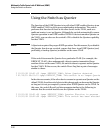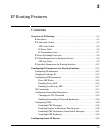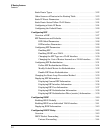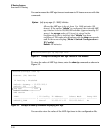
IP Routing Features
Overview of IP Routing
ARP Cache Table
The ARP cache contains entries that map IP addresses to MAC addresses.
Generally, the entries are for devices that are directly attached to the routing
switch.
An exception is an ARP entry for an interface-based static IP route that goes
to a destination that is one or more router hops away. For this type of entry,
the MAC address is either the destination device’s MAC address or the MAC
address of the router interface that answered an ARP request on behalf of the
device, using proxy ARP.
ARP Cache. The ARP cache contains dynamic (learned) entries. The soft-
ware places a dynamic entry in the ARP cache when the routing switch learns
a device’s MAC address from an ARP request or ARP reply from the device.
The software can learn an entry when the switch or routing switch receives
an ARP request from another IP forwarding device or an ARP reply. Here is
an example of a dynamic entry:
IP Address MAC Address Type Port
1 207.95.6.102 0800.5afc.ea21 Dynamic 6
Each entry contains the destination device’s IP address and MAC address.
To configure other ARP parameters, see “Configuring ARP Parameters” on
page 3-14.
IP Route Table
The IP route table contains routing paths to IP destinations.
Note The default gateway, which you specify when you configure the basic IP
information on the switch, is used only when routing is not enabled on the
switch.
Routing Paths. The IP route table can receive the routing paths from the
following sources:
■ A directly-connected destination, which means there are no router hops
to the destination
■ A static IP route, which is a user-configured route
■ A route learned through RIP
3-6


















